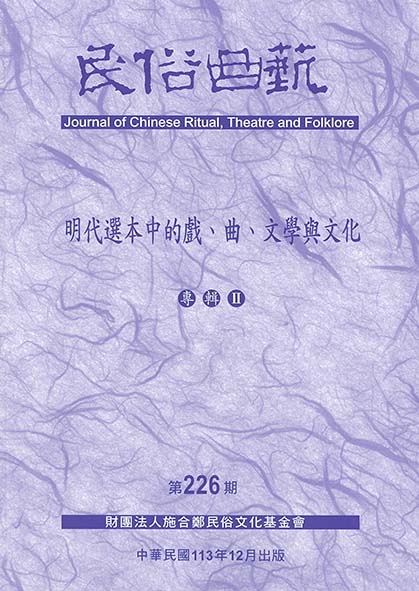
目录
明代選本中的戲、曲、文學與文化專輯(II)
前言(汪詩珮)
[專輯:研究論文]
“Different” Versions of Kunqu Singing Rules: Comparing Textual Variants in Nanci Yinzheng and Wei Liangfu’s Qulü in Late Ming Qu Anthologies / Yang Dan
Late Ming Wanderings through Space and Time: On the “Travel” Volume of the Yuefu Hongshan / Hsu Yung-fang
明代「虞初」系列選集對唐代小說的編選和評議/康韻梅
論晚明清初江右文士賀貽孫的泛戲曲評述及其意義/陳志信
[研究論文]
「我們穿得和山神(Yullha)一樣!」:安多熱貢六月會(Lurol)祭祀中的人神關係與服飾意涵/陳乃華
[調查報告]
「內山師公」的儀式傳統:以安溪老君派為探討對象/葉八方
摘要
Yang Dan. “‘Different’ Versions of Kunqu Singing Rules: Comparing Textual Variants in Nanci Yinzheng and Wei Liangfu’s Qulü in Late Ming Qu Anthologies.” Journal of Chinese Ritual, Theatre and Folklore 226 (2024.12): 7-28.
楊丹。〈「另一種」崑曲曲律:《南詞引正》與晚明曲類選本中的魏良輔《曲律》比較〉。《民俗曲藝》226 (2024.12): 7-28。
Abstract
Qulü曲律(Rules of Singing Qu) are influential singing guidelines for the performance of Kunqu authored by Wei Liangfu魏良輔(ca. 1526–ca. 1587). While primarily a treatise on the systematic principles of Kunqu pure singing, Wei’s Qulü also reflects the development of qu scholarship in the Ming dynasty. This text was circulated in both manuscript and printed form; the only surviving manuscript is entitled Nanci yinzheng南詞引正(The Guide to Correct Southern Lyrics) and contains a colophon dated 1547. Several printed qu anthologies from the late Ming incorporated Wei Liangfu’s Qulü in their prefaces. These editions, however, contain multiple textual variants. By examining several editions of this work, the present paper aims to discuss what can be learned from the textual variants of specific entries in the Qulü. First, the disappearance of information about Zhongzhou yun中州韻(Rhymes of the Central Plains) in printed editions can be cited as evidence to support the argument that, while Zhongzhou yun was still regarded as the basic principle for Kunqu singing, late Ming qu theorists made attempts to adjust the use of rhyme for southern qu. Secondly, the deletion of an entry entitled “correcting dialectal pronunciation” shows that the editors of late Ming qu anthologies were actively engaged in correcting perceived mistakes in Qulü by editing the text according to the style of the publication and their ideas when collecting Qulü into their anthologies. Based on this observation, I argue that editors of late Ming qu anthologies played a significant role in the development of Kunqu singing rules. Specifically, they deleted and revised problematic content, removing an entry on correcting dialectal pronunciation to bring Wei Liangfu’s rules into line with the local characteristics of their anthologies. In addition, they added their opinions about Kunqu pure singing into the text. These editorial activities helped to generate new versions of Wei Liangfu’s Qulü that differ from the Nanci yinzheng.
Hsu Yung-fang. “Late Ming Wanderings through Space and Time: On the ‘Travel’ Volume of the Yuefu Hongshan.” Journal of Chinese Ritual, Theatre and Folklore 226 (2024.12): 29-78.
許詠芳。〈晚明的時空漫遊:論《樂府紅珊》中的〈遊賞〉卷〉。《民俗曲藝》226 (2024.12): 29-78。
Abstract
During the late Ming Wanli era (1573–1620), zhezi xi折子戲(drama excerpts) were immensely popular, with troupes often needing to select appropriate plays for specific occasions. The Yuefu hongshan樂府紅珊(ca. 1602) is a methodically organized anthology of drama, with its subject matter structured into sixteen distinct juan卷(volumes), each dedicated to a specific theme. This structured organization is a defining feature of the Yuefu hongshan, which meticulously arranges selected dramatic scenes to align with themes that are relevant to specific occasions. This careful curation enhances how these scenes connect with viewers, resonating with their senses and emotions, and strengthening their cultural memories and feelings linked to special events.
This paper explores the complex relationships between the Yuefu hongshan and enduring memories of specific places and events, highlighting this work’s role in understanding the cultural landscape of that era. The focus of this study is on two excerpts from the tenth volume of the Yuefu hongshan (youshang遊賞, traveling and sightseeing): “Wuwang you Gusutai”吳王遊姑蘇臺(King Wu Tours Gusu Terrace) and “Wang Shang jiaji you Xihu”王商挾妓遊西湖(Wang Shang Takes Courtesans to Tour the West Lake). These excerpts are set against the scenic milieus of Suzhou and Hangzhou during the late Ming tourism boom. By analyzing drama excerpts, other drama publications, literati miscellaneous notes, paintings, and leishu類書(encyclopedias) from the late Ming period, the study aims to uncover how the Yuefu hongshan accentuates travel-themed scenes and cultural memories of touring. It explores the interplay between the dramatic content and sensory experiences of live performances and armchair traveling, as well as how these aspects align with the experiences of late Ming travelers.
康韻梅。〈明代「虞初」系列選集對唐代小說的編選和評議〉。《民俗曲藝》226 (2024.12): 79-134。
Kang Yun-mei. “Editorial Strategies and the Commentaries on Tang Tales in the Ming Yuchu Anthologies.” Journal of Chinese Ritual, Theatre and Folklore 226 (2024.12): 79-134.
Abstract
唐代小說一如唐詩在明代被廣泛的模擬、編選和評論,尤其明代印刷出版發達,小說選集刊行盛行,許多唐代小說因此被收錄、流傳。本篇論文企圖探究明代《虞初志》、《續虞初志》、《廣虞初志》等小說選集對唐代小說的選錄和評議。首先聚焦在此三本「虞初」系列選集選錄唐代小說文本的情況,以及彼此之間的衍生現象;其次分析三本「虞初」系列選集在篇題、作者,以及內容文字上與談刻本《太平廣記》的差異,進而揭示此差異在版本上的意義。最後則針對三本「虞初」系列選集對選錄的唐代小說所作之評論,作一探究,嘗試耙梳三本「虞初」系列選集的序跋和評點情況,特別是匯聚眾家序文、評點的凌刻本《虞初志》,進而闡釋其中對唐代小說評論的意蘊。希冀藉由此研究呈現唐代小說在明代的受容和經典化的歷程。
陳志信。〈論晚明清初江右文士賀貽孫的泛戲曲評述及其意義〉。《民俗曲藝》226 (2024.12): 135-67。
Chen Chih-hsin. “The Significance of Pan-Xiqu Commentaries in the Work of the Late Ming and Early Qing Jiangxi Literatus.” Journal of Chinese Ritual, Theatre and Folklore 226 (2024.12): 135-67.
Abstract
晚明清初江右文士賀貽孫(1605–1688)作了一些將戲曲同詩歌、時藝比附討論,姑可稱作「泛戲曲評述」的批評,對它們進行研究,或將提供吾人一個機會觀察戲曲在從前士人生活中扮演的角色,並評析是類論述的文學史意義。在論文伊始,我們嘗試先對賀氏早年的讀書、應試生涯進行考察,我們看到:賀氏主要是通過參與文社的途徑來獲取文化信息;而在同來自江西各地的科考考生砥礪時文、切磋詩藝時,看戲賞曲的活動亦不時穿插在他的生活中,發揮紓壓力、固情誼、展才藝及洩憤懣等功能。再者,透過梳理這些評論,我們認識到賀氏進行文藝批評的目的,主為實踐竟陵派提出的詩家需厚植學養的主張;然蓋因賀氏對戲曲具鑑賞力,對劇壇相關信息亦具敏感度,遂教他終能作出一則則分別就曲調豐富多變的音效、插科打諢的生動效果、劇文的縝密構思和妥貼的擬代筆法等曲藝美學來發明詩歌及時藝美感的評說。最後,連結到賀氏寫的幾闕或可權充戲文的婉約詞及一、兩首富戲劇性的詩歌,我們又會發現賀氏領略到的曲藝美學亦注入其創作中,從而讓他寫的部分抒情及諷諭詩詞顯得別具戲味。要之,既非專業劇評,亦非劇作家的賀氏能有此等表現,實反映該時戲曲嘗展現旺盛活力的史實,而這個發現就是此番研究的最大收穫。
陳乃華。〈「我們穿得和山神(Yullha)一樣!」:安多熱貢六月會(Lurol)祭祀中的人神關係與服飾意涵〉。《民俗曲藝》226 (2024.12): 169-216。
Chen Nai-hua. “‘Dressing Up as a Mountain God (Yullha)!’: Exploring Human-Deity Relationships and the Symbolic Significance of Clothing at the Lurol Festival in Amdo Rebgong.” Journal of Chinese Ritual, Theatre and Folklore 226 (2024.12): 169-216.
Abstract
安多熱貢位於羌塘與蒙古的邊際,向北是草原帝國之所在,地處河西走廊與藏彝走廊交叉口,與中原王朝交往頻繁。政治與宗教的交錯形貌,使安多熱貢焠煉出多元文明的表現與傳承體系。法國年鑑學派石泰安(Rolf Alfred Stein,1911–1999)關於西藏文明的著作《甘青川藏古代部落考》,將目光投注在漢藏交界的走廊區域,書中敘述傳統拉薩貴族家族竭力將家譜與原始部族相接,氏族貴族家庭有其先祖世系,山神(yullha)與氏族系譜的創立者有密切關連,山神被作為先祖來供養。本文以安多熱貢的六月會(Lurol)祭儀為核心,環繞着青海隆務流域沿岸的十二個部族,每年在農曆六月會依序在部落舉辦山神祭祀,至今仍活躍在民間。儀式中,各部落的參與者,不論男女老少皆穿着華美服飾,如同主祀山神般配戴「紅纓白氈帽」(phying zhwa),具備「神—人」共通的象徵意涵,祭儀被強調的山神階序,反映部落先祖在西藏贊普時期的等級關係。通過「神舞」祭祀,說明吐蕃王朝(633–842)的贊普崇拜如何在佛教化的山神信仰中找到新的土壤,成為「阿尼」祖先信仰的範疇;而儀式舞蹈中「軍舞」祭祀,則重現明永樂年間(1403–1424)中原王朝駐守到安多的歷程。通過從「吐蕃贊普後裔」或「明永樂屯軍」的不同脈絡和民間敘事,呈現漢—藏邊地(Sino-Tibetan borderlands)的多重歷史記憶。
葉八方。〈「內山師公」的儀式傳統:以安溪老君派為探討對象〉。《民俗曲藝》226 (2024.12): 217-53。
Yeh Pa-fang. “Guardians of Tradition: Investigating the Daoist Rituals of Anxi Laojun School.” Journal of Chinese Ritual, Theatre and Folklore 226 (2024.12): 217-53.
Abstract
安溪老君派道教傳統目前仍然傳衍於大文山地區及基隆河上游一帶區域,但是目前傳承隱密,而且經過時代變遷,儀式傳統出現極大的斷層。此外,老君派雖然非常活躍於臺北盆地周圍,但是缺少文獻記錄,因此吾人對其了解十分有限。本研究發現老君派儀式類別包含了醮事三獻、禳度以及齋事,惟獨醮事三獻保存較為良好,至於禳度和齋事目前多僅存小法事,少有機會成團完整演示。此外,老君派獨有的「代人觀」、「四字起七字合」的唱念以及雜揉道教、釋教與法派內容在在顯示本派獨有的特色。然而,目前老君派日漸式微,加上其他強勢宗教儀式專家的競爭,導致目前老君派道長不太願意傳法,這也造成老君派未來傳承的諸多問題。本文旨在探查目前老君派的道教儀式傳統以及僅存的儀式專家傳承概況,希冀補充學界先前的研究,並且提供未來研究的可能方向。
(本資訊經出版方授權發佈。)

